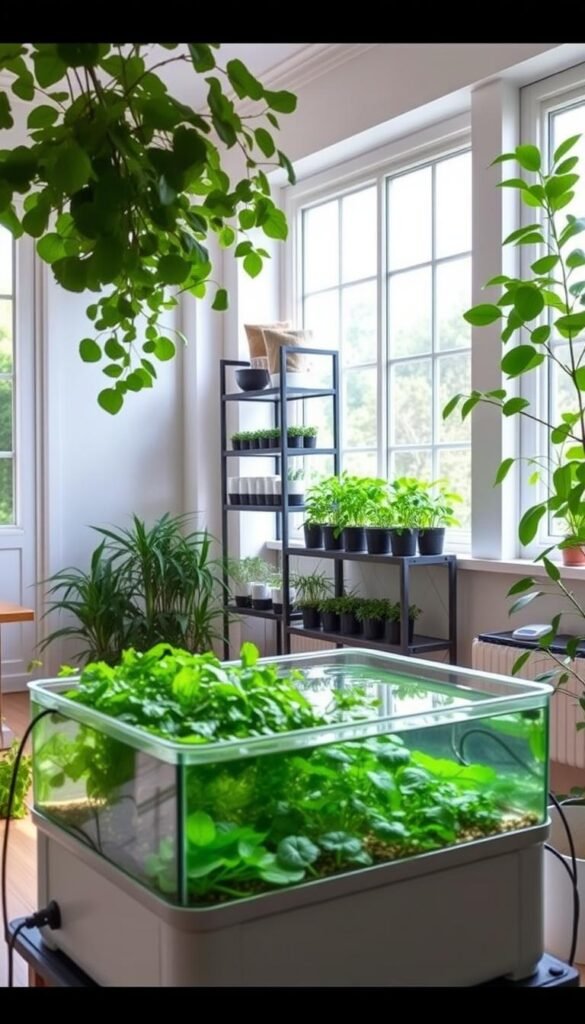Imagine growing fresh veggies and raising fish in one space-saving loop. This method uses recirculating water to create a mini ecosystem where plants filter waste from fish tanks. The result? Crisp greens and healthy aquatic life without constant upkeep.
You don’t need fancy equipment to start. A basic DIY setup can fit in small spaces like patios or garages. Fish like tilapia or goldfish provide nutrients for herbs or leafy greens, while plants clean the water naturally. It’s a win-win for your wallet and the planet.
Here’s how it works: Fish produce ammonia-rich waste. Beneficial bacteria break it into nitrates, which act as plant food. The roots absorb these nutrients, purifying the water before it flows back to the tank. No soil, no chemical fertilizers—just a self-sustaining cycle.
This guide will walk you through building an affordable system. You’ll learn which fish and plants thrive together, how to balance water pH, and ways to repurpose household items. Ready to turn leftovers into lettuce or basil? Let’s dive in.
Understanding the Fundamentals of Aquaponics
At its core, aquaponics works like nature’s recycling program. It connects fish tanks and plant beds through a water-based partnership. Instead of soil, plants thrive on nutrients from fish waste—and they return the favor by cleaning the water.
The Three-Way Team: Fish, Plants, and Bacteria
Your fish produce ammonia through their waste. Helpful bacteria convert this into nitrites, then nitrates—a form plants love. This step-by-step process feeds greens like lettuce or herbs while keeping the tank safe for aquatic life.
No chemicals are needed. The bacteria live on surfaces like grow bed media or tank walls. As water circulates, roots absorb nutrients, filtering it before it flows back. It’s a closed-loop system that mimics natural wetlands.
Aquaponics vs. Soil Gardening: What Changes?
Traditional gardens rely on soil and frequent watering. Aquaponics uses 90% less water since it recirculates. Plants grow faster because nutrients arrive directly to their roots. You also skip weeding and most pests.
Want to dig deeper? Our guide to aquaponic gardening basics breaks down the science. You’ll see how tilapia and basil can team up in your spare closet or balcony corner.
Exploring the Benefits of Aquaponic Gardening
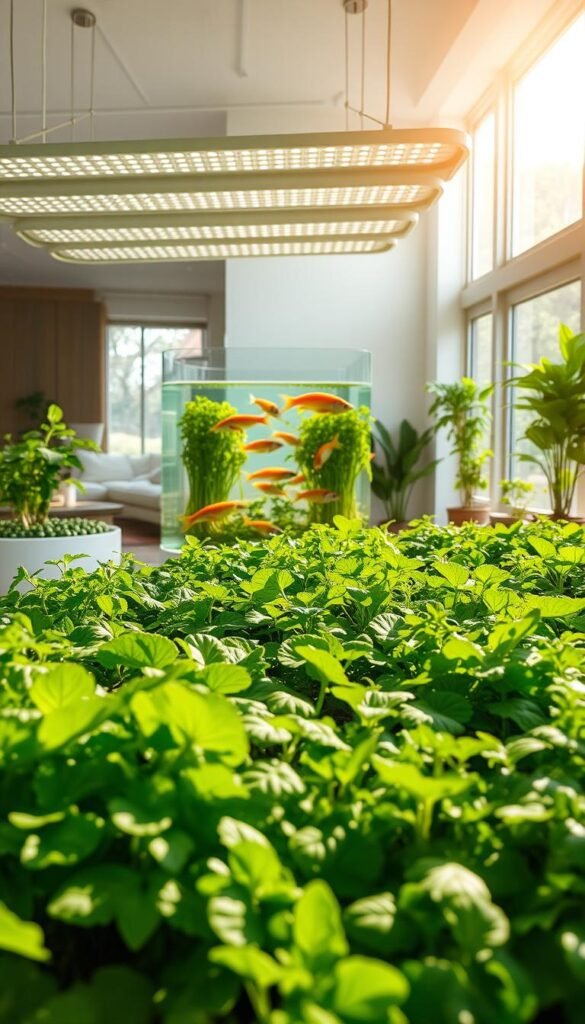
What if your veggies watered themselves while feeding fish at the same time? This method turns waste into wealth, creating a partnership that slashes resource use. Let’s unpack why this approach shines for eco-conscious growers.
Resource Efficiency and Sustainability
Traditional farming guzzles water, but these setups reuse over 90% of it. Unlike hydroponic methods, you’re not just recycling H₂O—you’re building a living ecosystem. Fish waste becomes plant food, and roots filter the tank. No chemicals. No runoff.
Imagine harvesting organic kale and tilapia from your garage. One family in Arizona grows 50 lbs of food yearly using a 100-gallon tank. Their secret? Letting bacteria handle the dirty work. Plants get constant nutrients, leading to faster growth without synthetic fertilizers.
Your wallet wins too. Less water means lower bills, and skipping soil cuts costs. You’ll dodge pests naturally since the closed-loop design discourages invaders. Healthy fish mean healthier greens—a cycle that thrives on balance, not constant inputs.
This isn’t just gardening. It’s a blueprint for resilient, small-scale food production. Whether you’re in a city apartment or suburban backyard, these systems adapt while keeping your environmental footprint tiny.
Key Components and Materials Required for Your System
The foundation of a thriving setup lies in its core components. Three elements work together: your fish tank, plant-growing space, and water movement tools. Choosing durable materials ensures your system runs smoothly for years.
Fish Tanks, Grow Beds, and Plumbing Essentials
Start with a sturdy fish tank—aim for 20+ gallons. Food-grade plastic containers work best for both tanks and grow beds since they resist corrosion. Avoid treated wood or metals that could harm aquatic life.
Your grow bed does double duty. It holds plants and houses beneficial bacteria. Use clay pebbles or lava rock as media. These porous materials give roots space to breathe while filtering water.
| Material | Durability | Cost |
|---|---|---|
| Food-grade plastic | High | $ |
| Fiberglass | Medium | $$ |
| Repurposed wood | Low | Free |
Connect your back fish tank to the grow area using PVC pipes or flexible tubing. A submersible pump moves water upward, while gravity pulls it back. Test for leaks before adding fish or plants.
Keep flow rates balanced—too fast washes away nutrients, too slow starves roots. Start with a 300 GPH pump for small setups. Add air stones if raising oxygen-sensitive species like tilapia.
Choosing the Right Fish and Plants for Your System
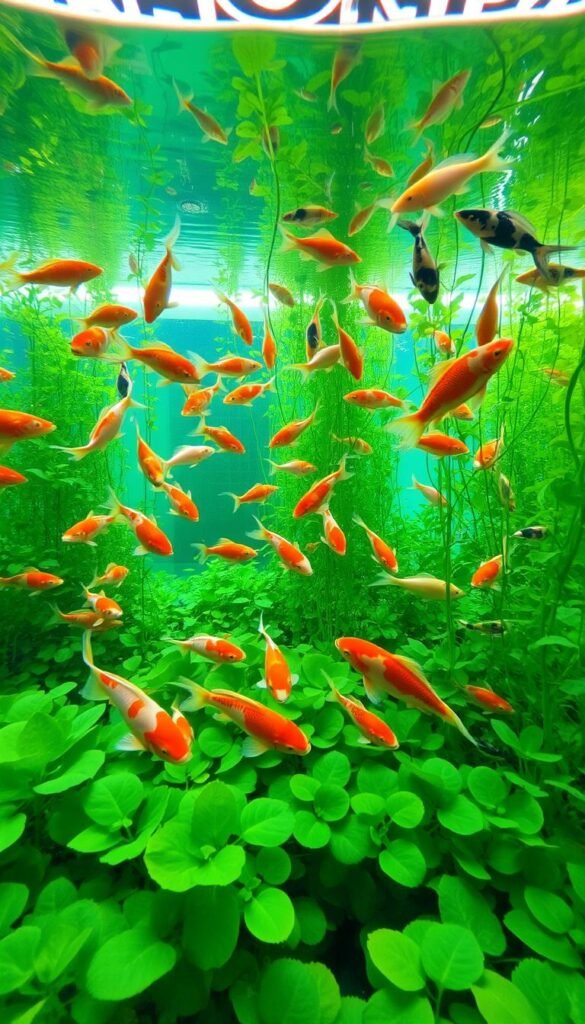
Pairing fish and greens isn’t just for dinner plates—it’s the secret sauce for a thriving setup. Your choices here determine how well nutrients flow and how little maintenance you’ll need. Let’s match species that play nice together while keeping your workload light.
Beginner-Friendly Species and Varieties
Start with hardy fish types like tilapia or goldfish. They tolerate water fluctuations and thrive in varied temperatures. Catfish also work well—they’re low-maintenance and grow quickly, making them ideal for new setups.
For plants, leafy greens like lettuce and kale are superstars. Their shallow roots absorb nutrients fast. Basil, mint, and other herbs flourish too, adding flavor to your meals while filtering water efficiently.
| Fish Species | Diet | Ideal Temp |
|---|---|---|
| Tilapia | Omnivore | 75-85°F |
| Goldfish | Flakes/Pellets | 65-75°F |
| Catfish | Protein-rich | 70-80°F |
Tips for Balancing Fish and Plant Needs
Feed fish small portions twice daily—uneaten food clouds water. Match plant quantities to your tank size. A 20-gallon system supports 4-6 fish and 10-12 leafy greens.
Test water weekly. Nitrate levels above 40 ppm? Add more plants. Below 20 ppm? Reduce greens or increase feeding slightly. This dance keeps both sides happy without chemicals.
Remember: Overcrowding stresses fish and starves roots. Start small, observe growth patterns, and adjust as your aquaponics system matures. Balance isn’t perfection—it’s steady adaptation.
Aquaponic Gardening on a Budget: Simple Home Systems
Who says sustainable food systems need to break the bank? With clever design and everyday items, you can craft a functional system that fits your space and wallet. Let’s explore how thrifty solutions deliver results without fancy gear.
Repurposed materials shine here. One DIY enthusiast transformed an old bookshelf into vertical grow beds, using PVC pipes for water flow. Another turned a kiddie pool into a back fish tank paired with plastic crate planters. These projects prove creativity beats costly equipment.
Balance is key. Your system needs reliable water circulation but doesn’t require industrial pumps. A $15 fountain pump moves liquid from the fish area to plants. Use gravel or recycled clay pellets as growing media—they’re cheap and host beneficial bacteria.
| Material | Cost | DIY Use |
|---|---|---|
| Plastic barrels | $20-40 | Fish tanks & grow beds |
| PVC pipes | $0.50/ft | Water channels |
| Secondhand pumps | $10-30 | Circulation |
Position your back fish container below the plant area. Gravity pulls water through the beds, cutting pump runtime. This setup slashes energy bills while keeping roots oxygenated.
Test your design with quick-growing plants like mint or spinach. They’ll show if nutrients flow properly. Adjust flow rates or add more media if leaves yellow. Small tweaks keep your home setup thriving without expensive sensors.
Remember: Consistency matters more than perfection. Check pH weekly and feed fish responsibly. Your low-cost system will mature into a resilient ecosystem, proving sustainability starts with smart reuse, not deep pockets.
Planning Your DIY Aquaponic Setup

Designing a system starts with smart planning. Before cutting pipes or buying fish, take time to map out your vision. This guide walks through three critical factors: available room, financial limits, and personal ambitions.
Measure Twice, Build Once
Start by measuring your available area. A balcony corner might fit a 20-gallon tank and vertical grow beds, while basements can handle larger setups. Note sunlight exposure and electrical outlets—these impact pump placement and potential indoor hydroponic setups.
Set clear goals. Want herbs for cooking? A compact system works. Aiming for fish harvests? Plan for bigger tanks. One urban gardener transformed a 4×4’ closet into a thriving lettuce-and-goldfish station using recycled containers.
Budget wisely. Repurpose old shelves for grow beds and use secondhand pumps. Track costs in three categories:
- Tanks and plumbing ($50-100)
- Fish and plants ($20-40)
- Testing kits ($15-30)
Balance aesthetics with function. Paint tanks to match your decor, but prioritize water flow efficiency. Test layouts with cardboard mockups before final assembly. Small steps today prevent costly fixes tomorrow.
Designing an Efficient Fish Tank and Grow Bed Setup
The right layout turns fish tanks into plant fuel stations. Your setup’s success hinges on how well water, nutrients, and space work together. Let’s break down the essentials for creating a smooth-flowing system that keeps roots fed and fish thriving.
Selecting Appropriate Materials and Containers
Durability matters. Choose food-grade plastic barrels or repurposed containers for your fish tank and grow bed. These resist corrosion and won’t leach harmful chemicals. Avoid metals—they rust and disrupt water chemistry.
Use PVC pipes or flexible tubing for water channels. They’re affordable and easy to customize. For media, opt for clay pebbles or gravel. They support roots while hosting beneficial bacteria.
| Material | Best Use | Cost |
|---|---|---|
| Plastic barrels | Tanks & beds | $20-50 |
| PVC pipes | Water flow | $0.60/ft |
| Clay pebbles | Root support | $15/bag |
Integrating Back Fish Tanks with Grow Beds
Position your back fish tank below the grow area. Gravity pulls water through the beds, reducing pump workload. Connect them using a submersible pump and tubing sized for your system’s flow rate.
Prevent clogs by adding a filter screen where water enters the grow bed. Space plants evenly so roots don’t block drainage. Test flow—water should trickle through media, not pool or rush.
One urban gardener used stacked crates for vertical growing above a repurposed bathtub tank. This saved floor space while ensuring roots got consistent nutrients. Adjust your design as you observe plant growth and fish behavior.
Step-by-Step Guide to Building Your Aquaponic System
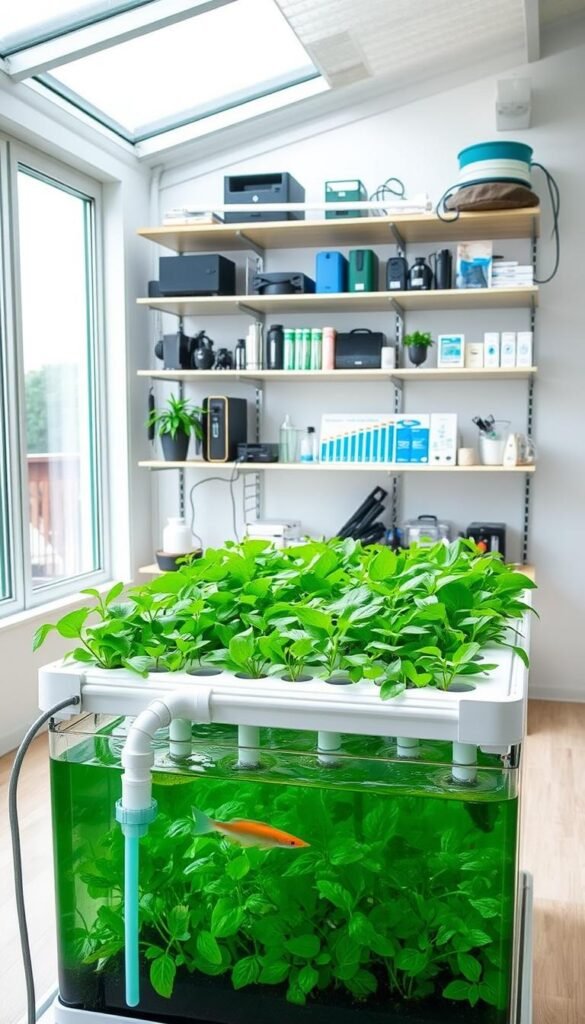
Roll up your sleeves—it’s time to transform spare containers into a living food factory. Start by choosing a flat, stable surface like a patio or garage floor. Uneven ground causes water pooling and pump strain. Use a carpenter’s level to check surfaces, adding shims under containers if needed.
Site Preparation and Assembly Tips
Gather these essentials before drilling holes:
- Drill with hole saw attachment
- Waterproof sealant
- Adjustable wrench
- PVC pipe cutter
Position your fish tank first. Leave 6-8 inches of clearance around it for maintenance. Connect the pump to the grow bed using flexible tubing—double-check connections for leaks. Test water flow with plain water before adding plants or fish.
| Site Checklist | Why It Matters |
|---|---|
| Level foundation | Prevents pump burnout |
| Near power source | Ensures consistent circulation |
| Partial sunlight | Balances plant/fish needs |
Watch video tutorials to visualize tricky steps like sealing bulkheads or spacing grow media. Beginners often forget to rinse clay pebbles—dust clogs filters fast. Assemble components in this order: tank, plumbing, grow bed, then media.
Secure pipes with zip ties to prevent kinks. Leave access panels for cleaning later. Your system should hum quietly—grinding noises signal air bubbles in the pump. Adjust flow rates until water trickles steadily through roots.
Optimizing Water Flow and Pump Circulation
Keeping your ecosystem thriving hinges on smooth water movement. Think of it as the bloodstream of your setup—delivering nutrients to plants and oxygen to fish. When circulation falters, roots starve, and fish gasp. Let’s fix that.
Mastering Flow Rates and Pipe Layouts
Your pump is the heart of the system. Choose one that cycles the entire tank volume every 1-2 hours. For a 50-gallon tank, a 300 GPH model works best. Too weak? Water stagnates. Too strong? Roots get battered.
Tubing size matters. Half-inch pipes handle small setups, while 1-inch widths suit larger systems. Avoid sharp bends—they restrict flow. Use gentle curves instead. One grower fixed murky water by switching from plastic to flexible silicone tubing.
| Pump Type | Flow Rate | Best For | Cost |
|---|---|---|---|
| Submersible | 200-500 GPH | Small systems | $25-60 |
| Inline | 600-1200 GPH | Large setups | $80-150 |
| Solar | Variable | Off-grid use | $100+ |
Add air stones if fish seem sluggish. They boost oxygen without stressing the pump. Test flow weekly—adjust the valve until water trickles evenly through all grow beds. Clogged filter? Soak it in vinegar overnight.
Lighting and Space Considerations for Indoor Aquaponics
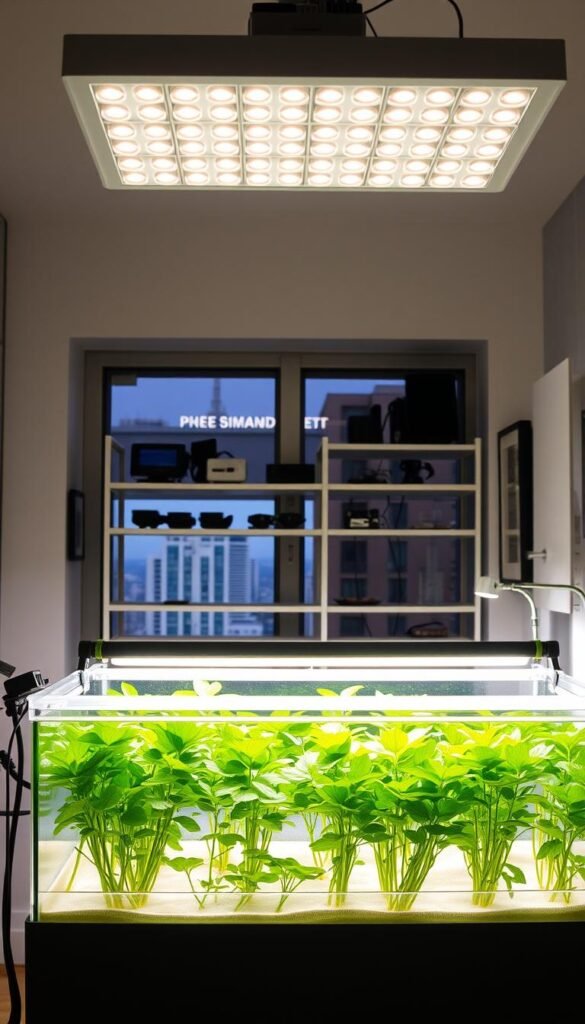
Bright ideas and smart layouts keep indoor setups thriving. Your plants crave light like fish need water—without it, growth stalls. But not all lights work equally. Full-spectrum LEDs mimic sunlight, giving herbs and greens the energy they need to flourish.
Position fixtures 12-18 inches above plants. Too close? Leaves burn. Too far? Stems stretch weakly. Pair natural window light with timed LED strips for 14-16 hours of daily exposure. This combo saves power while boosting yields.
Manage space wisely. Place tanks and grow beds near south-facing windows if possible. Use vertical racks to stack planters, ensuring each layer gets equal brightness. Reflective surfaces like white walls or foil-lined boards amplify existing lights.
| Light Type | Watts | Best For |
|---|---|---|
| LED Panels | 20-40 | Leafy Greens |
| T5 Fluorescent | 30-50 | Herbs |
| HID | 100+ | Fruiting Plants |
Set timers to match natural day cycles. Consistent schedules prevent stress on fish and roots. Low-wattage systems cut energy bills—a 25W LED can cover 4 sq ft of basil.
One urban grower transformed a closet using $30 shop lights and a timer. Their kale thrives under 14-hour cycles, while tilapia enjoy shaded tanks below. Balance is key: bright for plants, dimmer for fish.
Maintaining Water Quality and System Health
Think of your setup as a living recipe—every ingredient needs precise measurement. Just like baking, slight imbalances in your water chemistry can turn success into a soggy mess. Regular checks keep your fish active and plants vibrant.
Tracking pH, Ammonia, and Nutrient Levels
Test weekly with liquid kits or strips. Ideal levels look like this:
| Parameter | Safe Range | Danger Zone |
|---|---|---|
| pH | 6.8-7.2 | Below 6.0 or above 7.5 |
| Ammonia | 0-0.5 ppm | Over 1 ppm |
| Nitrites | 0 ppm | Any detectable level |
High ammonia? Reduce fish feeding. Low pH? Add crushed coral to your filter. A Florida grower fixed murky water by adding duckweed—it absorbs excess nitrates naturally.
Prevent spikes with 10% weekly water changes. Use dechlorinated tap or rainwater. Check pumps daily—clogs starve roots and stress fish. Healthy bacteria thrive when flow stays steady.
Your system thrives on routine. Note test results in a journal. Spot trends before they become emergencies. Balance isn’t static—it’s a dance you master step by step.
Tending to Plant Growth and Pest Management
Healthy greens start with smart care—not guesswork. Your setup thrives when you nurture plant growth while keeping pests at bay. Focus on airflow, root health, and balanced spacing to create a resilient ecosystem.
Pruning, Nutrients, and Pest Control Made Simple
Trim yellowing leaves weekly to redirect energy to new growth. Use clean scissors for herbs like basil—cut above leaf nodes to encourage bushiness. Overcrowded roots compete for resources, so thin seedlings early.
Boost nutrient levels naturally with compost tea or worm castings. Mix 1 cup of castings into 5 gallons of water for a gentle fertilizer. Test leaves for deficiencies—purple stems often signal low phosphorus.
| Plant Type | Spacing | Pruning Frequency |
|---|---|---|
| Leafy Greens | 6-8 inches | Every 10 days |
| Herbs | 4-6 inches | Weekly |
| Fruiting Plants | 12+ inches | Biweekly |
Combat pests without chemicals. Introduce ladybugs to devour aphids, or spray diluted neem oil (1 tsp per quart) under leaves. Sticky traps catch flying insects before they lay eggs.
Check roots monthly for rot—brown, slimy strands need immediate trimming. Healthy white roots mean your plants fish partnership works. Adjust feeding if growth stalls, but let nature handle most heavy lifting.
Incorporating Proven DIY Projects and System Designs
Creativity meets functionality in these real-world setups. From bathtub-based setups to vertical towers, innovative builders prove you don’t need deep pockets for effective aquaponics systems. One project repurposed an old dresser into stacked grow beds, using salvaged PVC pipes for water flow. Another transformed an IKEA shelf into a compact herb-and-goldfish station.
Video tutorials offer step-by-step guidance. A popular YouTube guide shows how to build a 50-gallon system using plastic barrels and a $20 pump. The creator demonstrates drilling holes, connecting tubing, and balancing fish-to-plant ratios—all in under 15 minutes.
| Design Type | Space Needed | Cost Range |
|---|---|---|
| Barrelponics | 4×4 ft | $80-120 |
| Vertical Tower | 2×2 ft | $60-90 |
| Window Sill | 1×3 ft | $30-50 |
Adapt designs to your space. Tight on room? Try floating raft beds in a shallow tank. Prefer visual appeal? Use glass containers for visible root growth. Always test flow rates before adding fish.
Join online forums for blueprints. Many share material lists and troubleshooting tips. A system built from recycled gutters and a stock tank recently went viral—proof that clever reuse trumps expensive kits.
Scaling Your Aquaponics Setup for Expanded Production
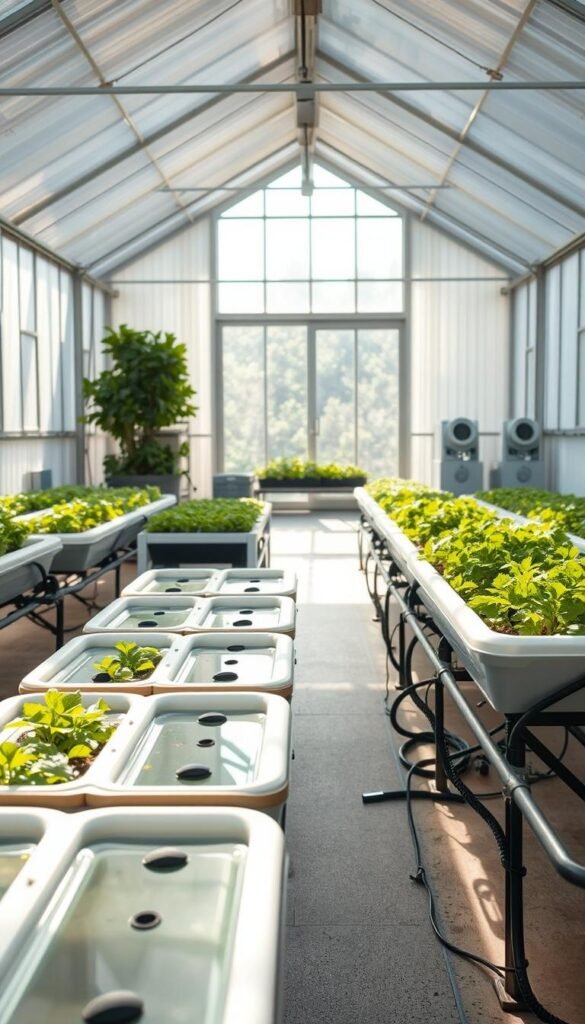
Ready to take your setup from patio project to powerhouse? Growing your operation doesn’t mean starting from scratch. Modular designs let you add components as your confidence—and appetite for fresh produce—expands.
Modular Expansion and Advanced Grow Methods
Think of your current system as building blocks. Connect additional grow beds or fish tanks using standardized fittings. One gardener doubled their lettuce output by stacking identical plastic crates vertically, each fed by the same pump. This “plug-and-play” approach keeps water chemistry stable while boosting yields.
Advanced techniques maximize every inch. Try staggered planting—harvest mature greens while seedlings establish. Deep water culture beds work well for larger roots like tomatoes. Pair these with floating rafts for herbs, creating layered nutrient absorption.
| Component | Small Setup | Scaled System |
|---|---|---|
| Fish Tank | 20 gallons | 100+ gallons |
| Grow Beds | 1-2 | 4-6 modular units |
| Pump Capacity | 200 GPH | 800+ GPH |
Upgrade pumps gradually. A 500 GPH model can handle two extra beds without straining. Test flow rates after each addition—roots need steady moisture without drowning. More fish? Increase aeration with additional air stones.
Balance remains key. For every 10 new plants, add 2-3 fish to maintain nutrient levels. Monitor pH weekly as your system grows. Successful scaling isn’t about size alone—it’s smart adaptation to support thriving life at every size.
Integrating Technology and IoT in Aquaponics
Smart tech meets sustainable farming in your backyard. Sensors and automation tools now let you manage your setup with phone alerts instead of guesswork. These innovations turn routine checks into effortless updates, freeing time while boosting yields.
Using Sensors, Timers, and Automation for Better Control
Imagine getting a text when nitrate levels dip or pH drifts. Wireless sensors track these metrics 24/7, sending data to apps like AquaMonitor or GrowTrack. Pair them with smart pump controllers that adjust flow rates automatically. No more midnight trips to check water levels.
Timers optimize power use. Set your pump to run during off-peak hours, cutting electricity bills. One user slashed energy costs 30% by syncing their system with solar panels. Lights and aerators can follow schedules too, mimicking natural cycles for healthier fish and plants.
| Device | Function | Cost |
|---|---|---|
| pH Sensor | Tracks acidity | $45-80 |
| Smart Pump | Adjusts flow | $60-120 |
| IoT Camera | Monitors growth | $30-70 |
Remote access changes everything. Vacation worries vanish when you can tweak settings from any location. Apps like FarmBot even suggest adjustments based on trends—like adding more greens if nitrates spike. Your system stays balanced without constant babysitting.
Start small. A $25 timer for your pump prevents overflows. Add sensors gradually as your comfort grows. Tech shouldn’t complicate—it simplifies, letting nature and data work together seamlessly.
Troubleshooting Common Aquaponics Issues
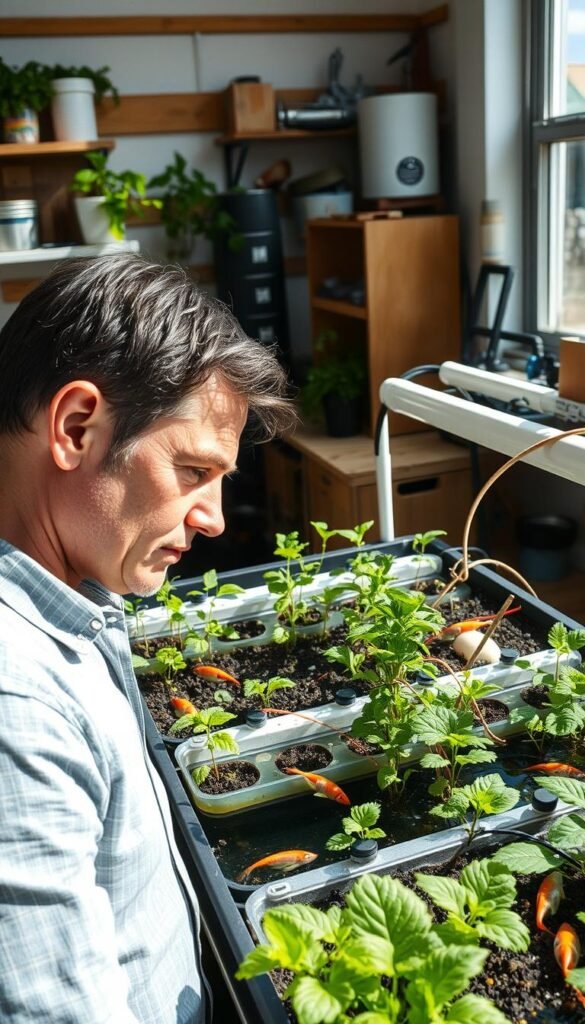
Even the best setups hit snags—here’s how to fix them fast. Algae blooms? Reduce light exposure with shade cloths or floating plants like duckweed. For pests, try spraying diluted neem oil under leaves every 3 days.
Identifying and Resolving Algae, Pest, and Flow Problems
Check water quality first. Cloudy liquid often means excess nutrients. Test nitrate levels—if above 40 ppm, add more greens or reduce fish feeding. Slimy surfaces signal algae; scrub gently with a soft brush.
Clogged flow? Inspect pump filters weekly. Clear debris from tubing using a pipe cleaner. If roots block drainage, trim them back and space plants wider. Uneven circulation stresses fish and starves roots.
| Issue | Quick Fix | Prevention |
|---|---|---|
| Algae Growth | Add barley straw | Limit light to 6 hours/day |
| Aphids | Release ladybugs | Use insect netting |
| Low Flow | Clean pump intake | Install pre-filter |
Keep a system journal. Note pH changes, fish behavior, and plant health weekly. Spot patterns before crises erupt. Balance isn’t static—it’s about adapting as your mini-ecosystem evolves.
Parting Thoughts and Next Steps for Your Aquaponic Journey
Your journey toward sustainable food production starts with a single step—and you’ve just taken it. By now, you’ve seen how resource-efficient systems turn fish waste into plant fuel while slashing water use. The growth potential is limitless, whether you’re nurturing herbs on a windowsill or tilapia in a garage setup.
Ready to act? Begin with a compact setup using repurposed containers. Track plant progress and water chemistry weekly. Join online forums or local groups to swap tips with the aquaponics community. Small tweaks, like adjusting light exposure or fish density, refine your system’s balance over time.
Next-level moves: Experiment with vertical designs to maximize space. Introduce new fish species once your home ecosystem stabilizes. Document results in a journal—patterns emerge faster when you note pH shifts and growth rates.
Remember: Every thriving system began as a trial run. Test one variable at a time—like adjusting flow rates or adding new greens. Your patience today cultivates tomorrow’s harvests. Now, roll up those sleeves and let nature’s teamwork shine.

